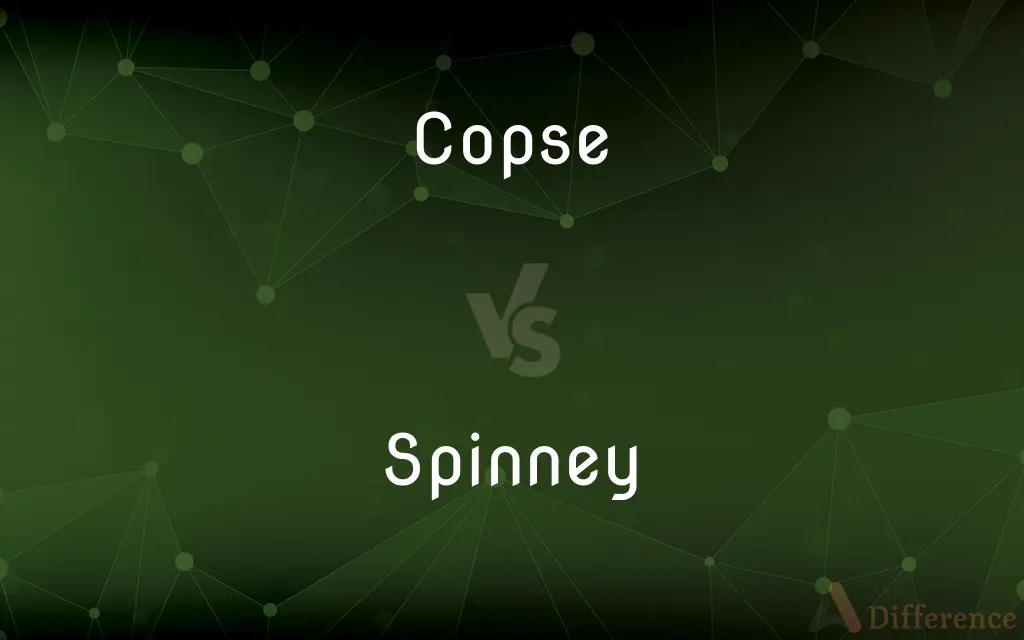Copse vs. Spinney — What's the Difference?
Edited by Tayyaba Rehman — By Maham Liaqat — Updated on April 4, 2024
A copse is a small group of trees, often a thicket used for woodcutting or as a habitat, while a spinney is specifically a small wood or thicket, usually planted for hunting cover or ornamental purposes.

Difference Between Copse and Spinney
Table of Contents
ADVERTISEMENT
Key Differences
A copse typically refers to a dense group of trees or bushes, small in size, that has grown naturally or has been planted for a specific purpose, such as woodcutting, habitat preservation, or landscape enhancement. It emphasizes the utility or natural aspect of the wooded area. In contrast, a spinney, while also a small wooded area, often carries the connotation of being planted or managed for specific uses, like providing cover for game during hunting or enhancing the beauty of a landscape. Both terms denote small wooded areas but differ slightly in their implied purpose and management.
Copses are often found in rural or semi-rural environments and can be the result of natural forest regeneration processes or deliberate planting. They serve multiple ecological functions, including offering habitat for wildlife, increasing biodiversity, and acting as windbreaks. Spinneys, on the other hand, are usually more managed or cultivated, often designed to fit into a larger landscaping scheme or serve recreational purposes such as hunting.
The distinction between a copse and a spinney can sometimes blur, as both describe woodland areas smaller than a forest and larger than a grove. However, the term "spinney" is more commonly used in British English and carries a slightly more formal or old-fashioned tone, suggesting an element of human intervention or design.
Both copses and spinneys contribute to the landscape's aesthetic and ecological balance, offering spaces for wildlife and enhancing natural beauty. They differ mainly in their perceived purpose—copses being more naturally inclined or utility-focused, while spinneys are often associated with human activities or ornamental intentions.
The choice between using "copse" or "spinney" can depend on the context and the speaker's or writer's preference, reflecting subtle differences in the wooded area's character, management, and purpose.
ADVERTISEMENT
Comparison Chart
Definition
A small group of trees or bushes, often naturally occurring or planted for specific purposes.
A small wood or thicket, usually planted or managed for hunting cover or as an ornamental feature.
Purpose
Woodcutting, habitat, landscape enhancement, natural regeneration.
Hunting cover, ornamental purposes, landscape design.
Management
Can be natural or lightly managed.
Often involves more deliberate planting or management.
Size
Typically small, larger than a grove.
Similar in size to a copse but emphasizes management or planting.
Common Usage
More general usage, can be found in various environments.
More specific, often associated with managed landscapes or historical estates.
Compare with Definitions
Copse
Habitat for wildlife.
Birds nested in the dense copse each spring.
Spinney
Reflects human intervention.
The spinney's layout was carefully planned.
Copse
A small group of trees or shrubs.
The deer emerged from the copse at dawn.
Spinney
Offers ornamental or recreational value.
We picnicked in the shade of the spinney.
Copse
Often found in rural settings.
A small copse marks the boundary of the farm.
Spinney
A small woodland, especially for hunting cover.
Pheasants were released in the spinney for the hunt.
Copse
Focus on ecological function.
The new copse increased the area's biodiversity.
Spinney
Planted or managed as part of landscape design.
The spinney was created to enhance the estate's beauty.
Copse
Natural or planted for utility.
The copse on the hill serves as a windbreak.
Spinney
Associated with British landscapes.
The spinney has been a feature of the countryside for centuries.
Copse
A small group of trees.
Spinney
A small grove; a copse.
Copse
A thicket of small trees or shrubs; a coppice.
Spinney
(UK) A small copse or wood, especially one planted as a shelter for game birds.
Copse
A coppice: an area of woodland managed by coppicing (periodic cutting near stump level).
Spinney
Clipping of spinnaker
Copse
Any thicket of small trees or shrubs, coppiced or not.
Spinney
Same as Spinny.
Copse
Any woodland or woodlot.
Spinney
A copse that shelters game
Copse
To trim or cut.
Copse
To plant and preserve.
Copse
A wood of small growth; a thicket of brushwood. See Coppice.
Near yonder copse where once the garden smiled.
Copse
To trim or cut; - said of small trees, brushwood, tufts of grass, etc.
Copse
To plant and preserve, as a copse.
Copse
A dense growth of bushes
Common Curiosities
What defines a spinney?
A spinney is a small woodland, usually planted or managed, often for hunting cover or as an ornamental feature within a landscape.
What is a copse?
A copse is a small group of trees or bushes, either naturally occurring or planted, often for specific ecological or utility purposes.
How big is a copse compared to a spinney?
Both are small woodland areas, but the exact size can vary; the distinction is more in their purpose and management than in size.
How do copses and spinneys differ in purpose?
Copses are more focused on ecological or utility functions, whereas spinneys are often designed for ornamental purposes or hunting.
How do I know if a wooded area is a copse or a spinney?
Consider its size, purpose (ecological, utility, ornamental, or recreational), and whether it appears to be naturally occurring or deliberately planted and managed.
Is a spinney always associated with hunting?
Not always, but it is traditionally planted or managed with hunting or ornamental purposes in mind.
Is there a legal difference between a copse and a spinney?
There is no specific legal distinction, but local land use regulations may differently address woodland areas based on their size, purpose, or management.
Can a copse be man-made?
Yes, a copse can be planted or managed by humans, although it can also occur naturally.
Do copses have any ecological benefits?
Yes, copses can increase biodiversity, provide wildlife habitat, and serve as windbreaks or natural filters.
Are copses common in urban areas?
They can be found in urban areas as part of parks or natural reserves, but they are more typical of rural settings.
Can both copses and spinneys support wildlife?
Yes, both can offer valuable habitats for a variety of wildlife, though the species supported may differ due to the variance in management and planting.
Why might someone plant a spinney?
For aesthetic reasons, to provide cover for game birds during hunting, or to enhance the recreational value of a landscape.
What historical role have spinneys played in landscapes?
Historically, spinneys have been important for providing hunting cover and enhancing the aesthetic appeal of estates and parklands, reflecting human influence on the landscape.
How does the management of a spinney differ from a copse?
Spinneys are often more deliberately designed and maintained, with a focus on aesthetic or recreational purposes, compared to copses which may be less intensively managed.
Can the terms copse and spinney be used interchangeably?
While they both refer to small groups of trees, their usage can depend on the context and specific characteristics of the woodland area, so they are not always interchangeable.
Share Your Discovery

Previous Comparison
Mauve vs. Pink
Next Comparison
Reasonability vs. ReasonablenessAuthor Spotlight
Written by
Maham LiaqatEdited by
Tayyaba RehmanTayyaba Rehman is a distinguished writer, currently serving as a primary contributor to askdifference.com. As a researcher in semantics and etymology, Tayyaba's passion for the complexity of languages and their distinctions has found a perfect home on the platform. Tayyaba delves into the intricacies of language, distinguishing between commonly confused words and phrases, thereby providing clarity for readers worldwide.















































